How to Make Ganache
This is a standard, easy, workingman’s ganache, great for baking applications. Ganache (pronounced ga-NAHsh) is most commonly a 50-50 combination of chocolate and heavy cream (by weight). Known as “soft” ganache, this is the kind that is typically used for toppings and drizzles, or whipped to make cake fillings. Heavier “firm” ganaches (say, 2-1 chocolate to cream) are more commonly used in candy and/or truffle making.
Here I should emphasize that when it comes to melting chocolate, I’m a microwave man. I find it much simpler, quicker and less risky than a double boiler or sauce pan. Where a typical ganache recipe will instruct you to “scald” your cream in a pan before you use it, that step is actually an anachronism, originally employed to kill bacteria, but no longer needed in the age of ultra-pasteurized dairy. The microwave is gentle, fast and to my way of seeing things, foolproof.
So then, start by putting your chocolate, however much you plan to use, in a microwave-proof bowl.
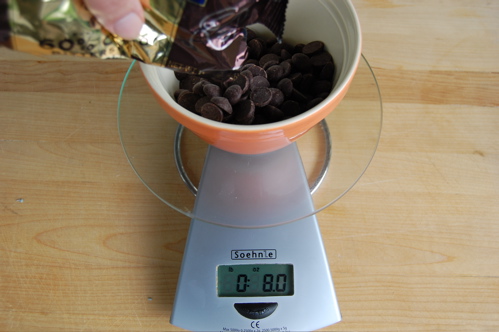
Pour in an equal amount of cream…
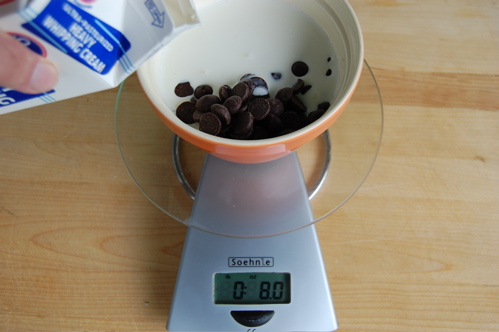
And insert in the microwave. Here I must emphasize that a microwave must be used judiciously where chocolate is concerned. Several short bursts on “high” are what’s required, as opposed to one or two long ones. I start with a 30-second zap, stir, and then use as many 20-second blasts as I need after that (generally about 4 for this much ganache).
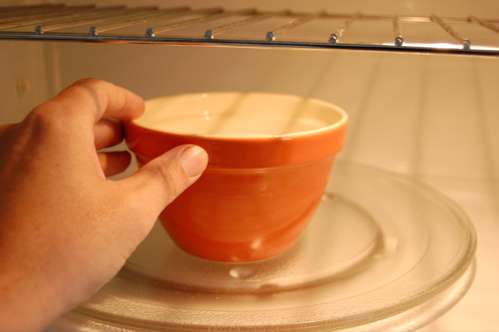
Three zaps and you can see there’s a little melting going on.
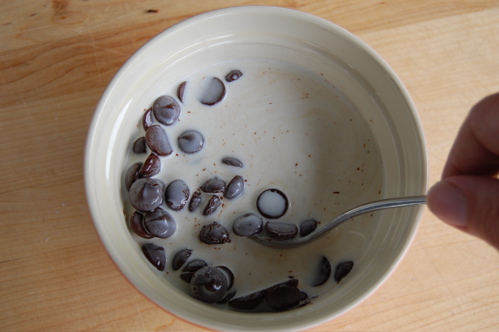
For shots and — oh no! My chocolate, it’s seized! Actually yes. “Seizing” is what happens when cocoa solids get wet. They swell up and stick together, creating clumps. But the thing about seizing is, it’s no big deal*, especially in this case, since ganache is a relatively watery mixture (as a result of the cream). As that water continues to mix with the sugar in the chocolate it will form a smooth syrup that will eventually re-lubricate the cocoa solids and create a smooth sauce.
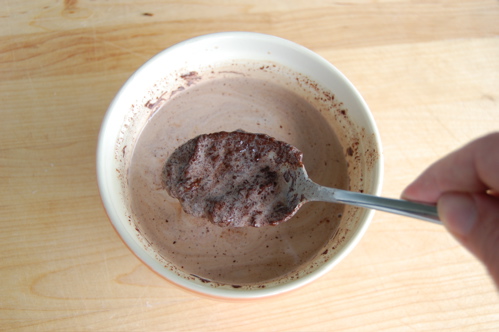
One more burst of microwaves and you can see that things are once again going my way. There are still quite a few unmelted chocolate chips, but by now I’ve built up enough heat that stirring will take me the rest of the way.
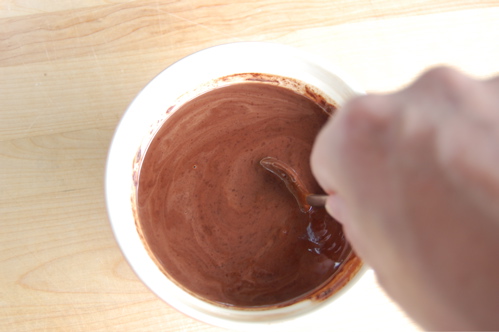
Another 45 seconds and we have touchdown. The ganache emulsion-with-a-suspension has been achieved.

This ganache is ready to use as, say, an éclair topping. If you were planning to use it for a truffle or some other longer-lasting application, like maybe to cover a cake, you’d want to add a tablespoon of corn syrup to inhibit runaway crystallization of the cocoa butter (that white film that melted and re-hardened chocolate often gets).
Some crystallization, however, is important for a ganache, which is why a warm ganache should always be allowed to sit at room temperature for at least a few hours before being refrigerated. That gives the fat in the ganache time to form a limited crystal structure, without which the ganache will become limp and greasy.
Lastly, I should insert that ganaches can be flavored. Some people simply add a little vanilla (or other extract) to the finished product to add complexity. Some people add a little booze or shot of liqueur. Me, I frequently like to get jiggy widdit by infusing the cream with various types of tea or herbs like lavender or lemon verbena. This of course requires a saucepan since you’ll want to add your whatever-it-is to your cream and simmer it until you have as much flavor infused into the cream as you wish. When that point is reached you simply strain out your leaves and carry on as usual.
* Should your chocolate seize on you when you’re melting it for a non-ganache application, don’t panic. Simply keep adding warm water, a few drops at a time, until the chocolate smoothes back out again.
Dear Joe,
I need to understand the difference between couveture chocolate and regular chocolate that we buy in bars such as Lindt, Hersheys etc.
Also is there a difference between regular chocolate sold in bars and cooking/baking chocolate? Also,when a recipe calls for bittersweet chocolate for melting as par of the recipe are they referring to the same chocolate bars or is this bittersweet chocolate something all together different.
Excuse my ignorance with regards to chocolate.
Regards,
Gauri.
No problem at all, Gauri! The posts I put up earlier this week on couverture will explain the difference between normal bars of “eating” chocolate and couverture. Hershey’s definitely isn’t couverture, but the more expensive Lindt bars might well be couverture. It’s all a matter of how much cocoa butter is in the mix, and how finely the chocolate solids have been ground.
As for the difference between baking chocolate and and bar chocolate, there isn’t much — if any — difference there. Chocolate used for baking is usually some sort of dark chocolate (i.e. not milk chocolate), and is generally of a lower quality than bar chocolate. Just about any sort of dark or bittersweet chocolate is good for baking.
Regarding your last question, bittersweet chocolate is the same for baking and for eating. It’s a dark chocolate that can be purchased in chip form or in bar form. Either way it’s the same thing.
Thanks for the questions and get back in touch if you have any others! Cheers,
– Joe
Hello Joe,
I hope you may be willing to help with a recurring problem I’ve been having with a chocolate frosting made of ganache, butter and powdered sugar.
The ganache is made first (1.4:1 semisweet chocolate to cream, to be exact), and allowed to sit at room temperature.
Then it’s added to room temperature butter beaten with powdered sugar, with the whole mixture further beaten until it lightens in color and thickens.
The cooled ganache is pretty dark, and before letting it sit I try to make sure that all the chocolate has melted.
The finished frosting is a lot lighter, and though I don’t seem to notice the specks when the mixer is running, while I’m spreading it over the cake, there definitely are specks of hardened chocolate in it.
Not exactly the effect I was going for…
Do you have any idea what the cause is?
Do I let the ganache sit too long, before combining it with the butter?It’s still soft when I add it to the beaten butter-sugar mixture…
I hope you can find the time to respond, and thank you for reading this, anyway.
Thank you, Joe!
Hello Michi!
That is an interesting problem. Are you getting a skin on top of the ganache as it cools? That’s my first thought. Try applying plastic wrap to the surface of the ganache as soon as you pour it into the bowl, then let it cool that way. If that doesn’t seem like a possibility get back to me. We’ll get it figured out!
– Joe
Hello Joe!
Thank you so much for your kind response! And very helpful, too…
On my next trial I’ll do that. It makes a lot of sense… Thank you!
I think I may also use an immersion blender this time to make sure the chocolate and cream are completely blended and smooth. I don’t like using it because some of the stuff always gets stuck under the shield and between the blades. And the use of an extra tool, just to make a ganache?!? But if that’s what it takes… So, I’ll see how it goes.
Thank you so much, Joe, really. And happy holidays!
It’s my pleasure to help, Michi. I use an immersion blender to make ganache a lot of the time, and you’re right, it is a bit of a pain in the neck. Let me know how things progress. If a chocolate “skin” isn’t the problem we’ll keep plugging away until we solve it — because I’m curious myself!
Cheers,
– Joe
We made this today with an allergy-friendly cupcake recipe, http://www.kidswithfoodallergies.org/featured_recipe5.php and yours as frosting.
We have egg and milk allergies in our home. We used a CAN of full-fat coconut milk instead and allergy free (Enjoy Life brand) mini chocolate chips.
Turned out marvelous. Cooked a little faster in microwave I think because they are mini chocolate chips. Tasted amazing.
Just a thought to include allergy variations as you think of them. From 1997 to 2011 food allergies in children has risen 50% according to the cdc. So a lot of mamas like me now bake everything from scratch and have it figure out substitutes. Its a joy though, just thought I’d share!
Thanks so much, Danielle. And I shall do that!
Cheers,
– Joe
My email address is above correct. Sorry last one had a typo. 🙂
Thanks for the great information, this website is a treasure trove! How far ahead can ganache we made? How should it be handled after removing it from the refrigerator to make it usable again? Thank you!
Hi Beth!
Thanks so much! Ganache will keep well for a week or more in the fridge, but wrap it tightly to prevent it from taking on any odors. Once it’s out of the fridge you can just let it warm up if you want it form, or you can soften it or melt it with a few quick zaps on high in the microwave.
Have fun!
– Joe
Hai Joe,
Just to enquire what if I am using whipping cream instead of heavy cream to make ganache? I couldnt find heavy whipping cream or heavy cream because I am from Malaysia so if I‘m using whipping cream to make ganache, do I have to let it set overnight? I‘m making birthday for my niece birthday soon…hope to hear your opinion..
Hi Joe!
I managed to ruin a big batch of ganache yesterday (in my defense I have to say that this has been a totally crazy week, with a new very young puppy after ten years of not having a dog, a 10yo boy even more excited than the new puppy, me quitting smoking 3 – no, 4 – days ago; with a huge, complicated cake to make for today, and with 3 boys and a dog running around the apartment for a few good hours yesterday afternoon, while I was baking/cooking/planning… 😀 ) – so of course I ruined my ganache, using a ratio based on volume instead of weight. Yes, I know, rookie mistake, I’m ashamed, I was clearly not in the kitchen while I was working but somewhere on a nice beach, with the ocean and the palm trees and the hot sand! So this morning at 6, after careful consideration along a cup of coffee and, of course, after realizing what was my mistake, I started a new ganache – because what can one do at 6 am on a Saturday morning other than make a chocolate ganache, right? LOL
And to finally get to the reason why I wanted to write this – while I was stirring the ganache-to-be in the bowl, it seized, and of course I remembered your tutorial on ganache and heard a voice in my head saying “oh no! My chocolate, it’s seized!”… then I realized how crazy this was and I started laughing out loud alone in the kitchen, at 6 am on a Saturday morning, over a (very fine, I might say…) raspberry chocolate ganache! 🙂
Thanks for being here for us all!
Ioana
PS: if you’re wondering what will happen with that big batch of it-might-have-been-ganache, I was thinking that instead of fixing it into a proper one (ganache, that is), rather mixing it with whipped cream and gelatin and see if I can obtain a nice, delicate raspberry/chocolate mousse. What do you think?
Hey Ioana!
Thanks very much for that, I appreciate it greatly!
If you still have the failed ganache I’d think you could whip it into something very nice indeed!
Cheers,
– Joe
PS – Congrats on quitting smoking and on the puppy. My 10-year-old is bananas for dogs, and after a year is still completely smitten by ours. She’s still cleaning up after her a year later. That’s true love!
Thanks! After 3 weeks my 10 yo son is still cleaning after the puppy; we’ll see what happens a year from now! 🙂 He always wanted one but couldn’t convince me while we were back in Montreal… now that we moved to Vancouver it seemed only natural to have one. Not really helping with the baking, though! :))))
As for the failed ganache, it ended up mixed with the non-failed one and it worked great. I noticed I was going to be short on the ganache for the cake and seeing that the first one was finally starting to show a decent consistency I told myself “it’s all or nothing” (thinking that I would have had to make another one to supplement anyway, so what was there to lose? 😀 ) and I mixed them and it worked – I got enough of this beautiful, delicately perfumed ganache for that huge cake and couldn’t be happier!
Nice!
So a happy ending then. Thanks for getting back with me, Ioana!
Cheers,
– Joe